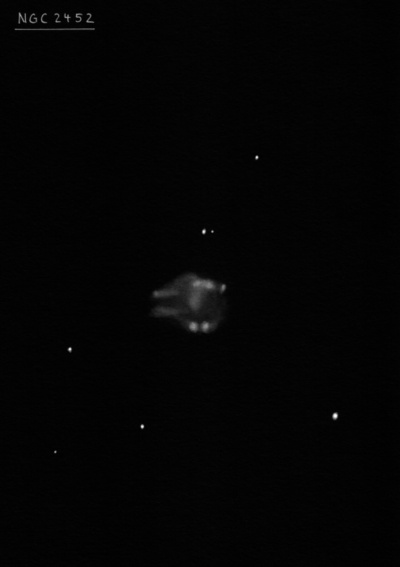
John Herschel discovered NGC 2452 = h3100 on 1 Feb 1837 and described as "An object whose nature I cannot make out. It is certainly not a star, nor a close double star; but it is not round, and I should call it an oblong planetary nebula, by reason of its decidedly marked though somewhat dim outline, were there not some suspicion of its being double, as if a very close and highly condensed double nebula. It is very small and rather faint, 8" long, 5" broad, and equals a star of 10th mag. In a field with at least 60 or 80 stars [NGC 2453], all sharp and well defined but this. Four nights later he recorded "Planetary nebula. In a field with, and south of a cluster, and on a rich ground is the undefined object of Sweep 769. It is no doubt a very faint, small, round planetary nebula..."
A lithograph was prepared based on a sketch by Joseph Turner using the Great Melbourne Telescope (plate V, figure 44) but his drawing was never published.
Based on a Crossley photograph at Lick Observatory, Curtis (1918) reported "there is probably a faint central star, not brighter than mag 19. Extreme length about 22" in pa 85° the centers of the bright lateral lobes are 11" apart. In this exposure time the object has much the appearance of a reversed letter Z." Based on radial velocity, NGC 2452 is in the foreground of open cluster[NGC 2453.
300/350mm - 13" (3/24/84): moderately bright, small, slightly elongated N-S, no interior star visible. Located 6' S of open cluster NGC 2453.
400/500mm - 17.5" (3/2/02): at 380x this is a moderately bright, fairly small but interesting planetary. Appears elongated N-S, ~30"x20" with an irregular surface brightness and a slightly darker center or a darker spot. The halo appears brighter at the north and south ends giving a slightly bipolar appearance with the impression of two lobes diminishing in brightness in the center. A faint mag 14.5 star is just off the north edge. Located 8' S of open cluster NGC 2453.
Notes by Steve Gottlieb